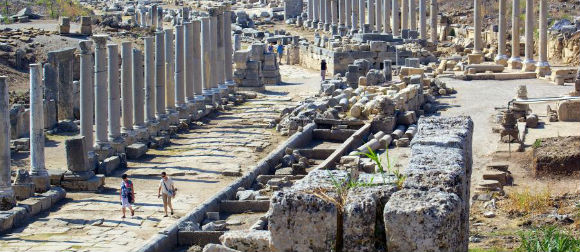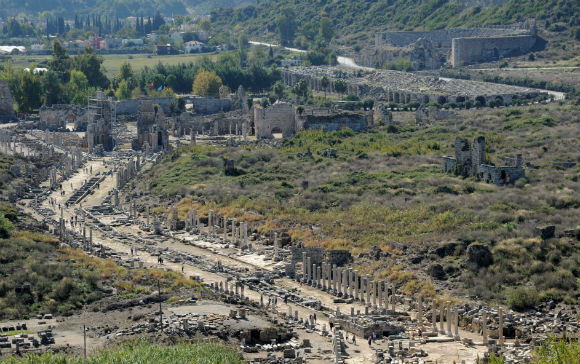The most impressive ruins of the Pamphylian coast are at Perge, at about 15 km east of Antalya. Perge was originally founded by the Hittites around 1500 BC. and was known as Parha. It was a successful trading centre near the Aksu (ancient Kestros or Cestrus) river when Alexander the Great arrived in 333 BC. He was welcomed in by the inhabitants and used Perge as base for his Anatolian campaigns. Alexander was followed by the Seleucids under whom the city prospered and Perge’s most celebrated inhabitant, the mathematician Apollonius from Perge lived and worked. Apollonius was a pupil of Archimedes and wrote a series of eight books on geometry. In 188 BC Perge became part of the Roman Empire during which the city flourished. Most of the surviving buildings date from this period.In 46 AD St. Paul started his journey in Perge (biblical Perga) and preached his first sermon here. Perge gradually declined during the Byzantine period, as the Aksu river silted, but remained inhabited until Selçuk times after which it became abandoned.
A visit to Perge starts by entering the archeological site through the Roman Gate, built during the reign of Septimius Severus (193-211 AD). Proceeding through the gate, to the right is the Agora or market place. This structure of 75 x 75 m dates back from the 2nd century AD. The center courtyard and shops were surrounded by a wide stoa, a covered walkway. The floor of the stoa and shops was made of colored mosaics. The agora was not only the centre of Perge’s trade, but was also a place for meetings as well as a forum for political, social, and philosophical discussions. The next building is the Hellenistic city gate that dates back to the 3rd century BC. This is certainly the most imposing building of the city and was cleverly designed to protect the city with its twin towers and its horseshoe-shaped courtyard at the back. It is thought that the towers had three floors and were crowned by a conical roof. In the year 121 AD, the horseshoe-shaped courtyard was rededesigned as a courtyard of honor. Behind the courtyard stood a triple arch. Around the arch there are about dozen inscriptions connected with Plancia Magna who lived in the 2nd century AD. She was the daughter of the governor, a priestess of Artemis Pergaia (Diana) and a benefactress to the city. Plancia Magna had the arch decorated with the statues of the emperors and their relatives.
After passing through the Hellenistic Gate and courtyard, one enters a broad, marble-paved double-colonnaded street measuring 300 meters in length that extends from the main gate to the acropolis. The street is 20 m wide and is divided in two by a 2 meter wide water channel running down the middle. At the end of the colonnaded street is the Nymphaeum, a triumphal fountain from where a stream flowed down into the water channel. The nymphaeum or nymphaion is an ornamental semicircular structure and dates from the reign of Emperor Hadrian (130-150 AD). A statue of a river god Kestros was located in the center of this huge fountain. Behind the nymphaeum is the acropolis with some remains of the Byzantine period. To the west of the nymphaeum are the remains of a palaestra dating from 50 AD and dedicated to the Emperor Cladius (41-54 AD).
Returning back to the entrance, there are the excavated Roman baths located southwest to the agora. Out of the site proper, is the horsehsoe-shaped stadium, the largest in Asia Minor, measuring 234 m by 34 m. The stadium had a seating capacity of 12,000 people supported by massive barrel-vaulted constructions. Just beyond the site entrance is also the theatre, which is of the Greco-Roman type and could seat 15,000 people. Unfortunately, it is for some time under reconstruction and unfortunately closed to visitors.
Perge,



This is a fantastic historical site reflecting centuries of history. Most of the ruins date from Roman times although the City's history goes back many centuries before.
The Roman baths system, main street and marketplace are all quite magnificent.
Just outside the main site there are the ruins of an impressive stadium.
We went on an organised tour with a…
A must see if you are visiting the Antalya area. Try to book a tour to the sites you will be able to see them much easier than doing it on your own. Very well preserved Roman/Greek ruins. Great photo opportunities. A do not miss on your holiday.
Canmom another DE for Antalya kindly took us out for the day and what a day it was.
Our first stop on this latest sight seeing trip was Perge having been with her to Aspendos previously !
We first stopped to see some ruins leading up to the site.It was a surprise how close Perge is to our luxurious hotel…
Perge is simply that. Having stumbled around Termessos and fought our way around Sillyon, the access to Perge is a much appreciated relief. The site is pretty much on the level and, architecturally, it has more to offer the visitor than any other Roman/Hellenic Pamphylian city. The large bath complex has some stunning marble columns, although wherefrom I don't know….
Perge was wonderful site, inhabited by Hittites many centuries prior to the arrival of the Greeks
The ruins at Perge are worth visiting if you happen to be in Antalya. Ephesus and Acropolis are more interesting.
You need to see the artifacts at the Archeological Museumm to really appreciate what an important site this is.
Its very close to the town of Antalya.The well preserved Roman baths were very interesting with their caldarium intact.There was also the huge agora,huge Hellenistic city gate and a very interesting small market selling souvenirs.
Well worth seeing. But don't miss Pharselus, as that is probably even better. Abandoned Greek town to the S.W. Olympus is good for a laugh too – it has been taken over by a hippy commune.
A lot to see (and quickly if you go with a coach tour!). Can't believe how much still remains here. We saw it as well as Side and Aspendos on an organised coach tour, we would have liked more time to explore, say 1-2 hours. I would also have liked to look at the stadium in more detail but it…